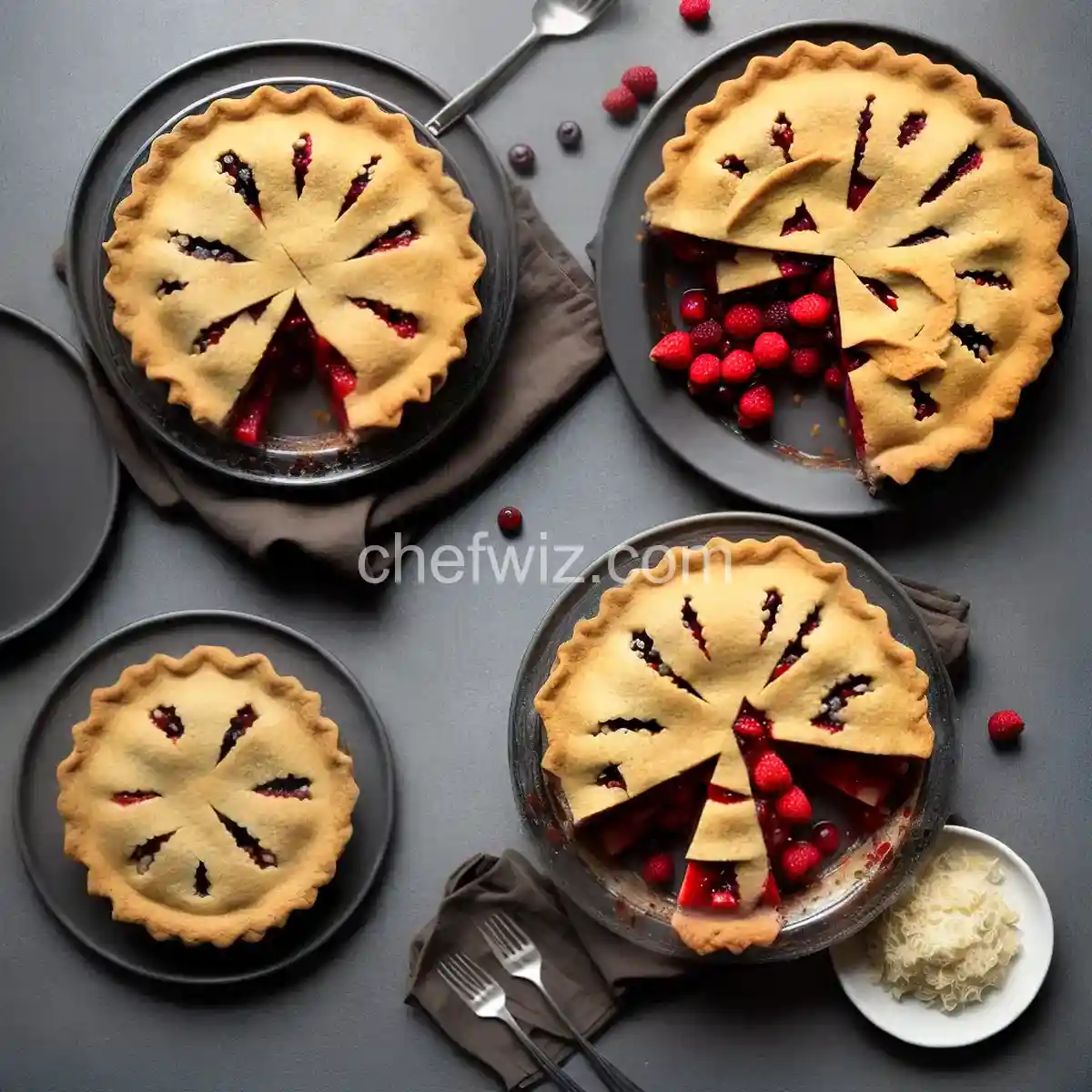Japanese Fruit Pie: A Deliciously Unique Dessert
Have you ever tasted a dessert that transports you to a different world with just one bite? Imagine a pie that combines the flavors of sweet tropical fruits, warm spices, and a buttery crust that melts in your mouth. That’s what Japanese Fruit Pie is all about – a unique and delightful dessert that will leave you craving for more.
The Origins of Japanese Fruit Pie
Despite its name, Japanese Fruit Pie does not actually originate from Japan. Its roots can be traced back to the southern United States, where it has been a beloved dessert for generations. The pie is often associated with the holiday season and is a staple on many Thanksgiving and Christmas dinner tables.
What Makes Japanese Fruit Pie Different?
Japanese Fruit Pie stands out from other pies due to its distinct combination of ingredients. While traditional pies often feature fruit fillings, Japanese Fruit Pie takes it up a notch. It combines a variety of dried fruits like raisins, dates, and figs, along with nuts, spices, and a touch of bourbon to create a complex and irresistible flavor profile.
The Perfect Balance of Sweetness and Warmth
What sets Japanese Fruit Pie apart is the way it balances sweetness with warmth. The dried fruits provide a natural sweetness, while the spices like cinnamon and nutmeg add a warm and comforting touch. The result is a pie that is rich in flavor but not overly sweet, making it a perfect dessert for those who enjoy a subtle sweetness.
How to Enjoy Japanese Fruit Pie
Japanese Fruit Pie is best enjoyed warm, straight out of the oven. The buttery crust becomes flaky, and the filling becomes gooey and delicious. You can serve it as is or add a scoop of vanilla ice cream for an extra indulgence. The contrast between the warm pie and cold ice cream creates a delightful sensory experience.
Where to Find Japanese Fruit Pie
While Japanese Fruit Pie might not be as well-known as other desserts, you can still find it in select bakeries and specialty dessert shops. If you’re lucky, you may even stumble upon a family recipe passed down through generations. Alternatively, you can try making it at home and share this delightful treat with your loved ones.
The Joy of Baking Japanese Fruit Pie
Baking Japanese Fruit Pie is not only an opportunity to indulge in a delicious dessert but also a chance to create lasting memories. Gather your family or friends in the kitchen, roll up your sleeves, and embark on a culinary adventure together. The process of mixing the ingredients, rolling out the dough, and baking the pie is a labor of love that makes the final outcome even more satisfying.
Frequently Asked Questions (FAQs)
Q1: Can I use fresh fruits instead of dried fruits in Japanese Fruit Pie?
A1: While dried fruits are the traditional choice for Japanese Fruit Pie, you can experiment with fresh fruits. Keep in mind that the texture and sweetness may vary, so adjust the recipe accordingly.
Q2: Can I omit the bourbon in the pie filling?
A2: Yes, you can omit the bourbon if you prefer a non-alcoholic version of Japanese Fruit Pie. The pie will still be delicious and flavorful without it.
Q3: How long does Japanese Fruit Pie stay fresh?
A3: Japanese Fruit Pie can be stored in an airtight container at room temperature for up to three days. However, it is best enjoyed fresh or within the first day or two.
Q4: Can I freeze Japanese Fruit Pie?
A4: Yes, you can freeze Japanese Fruit Pie. Wrap it tightly in plastic wrap or foil before placing it in the freezer. When ready to enjoy, thaw it in the refrigerator overnight and reheat it in the oven for the best results.
Q5: Is Japanese Fruit Pie gluten-free?
A5: Traditional Japanese Fruit Pie is not gluten-free due to the wheat flour used in the crust. However, you can try adapting the recipe using gluten-free flours for a suitable alternative.
Q6: Can I add different spices to Japanese Fruit Pie?
A6: Absolutely! Japanese Fruit Pie is versatile, and you can experiment with different spices to suit your taste. Consider adding a hint of ginger or cardamom for an extra kick of flavor.
Q7: Can I make mini Japanese Fruit Pies instead of a large pie?
A7: Yes, you can make mini Japanese Fruit Pies by using individual tart pans or muffin tins. Adjust the baking time accordingly, as they will cook faster than a large pie.
Q8: Can I serve Japanese Fruit Pie cold?
A8: While Japanese Fruit Pie is traditionally served warm, you can also enjoy it cold. However, keep in mind that the flavors may not be as pronounced when chilled.
In Conclusion
Japanese Fruit Pie is a unique and delicious dessert that offers a delightful blend of flavors. Whether you choose to enjoy it warm with a scoop of ice cream or savor it cold, this pie is sure to leave a lasting impression. So go ahead, indulge in a slice of Japanese Fruit Pie and let your taste buds embark on a sweet and savory journey.

Japanese Fruit Pie
Ingredients
- 1 (9 inch) pie crust , uncooked
- 2 eggs , beaten
- 1/3 cup melted butter
- 1 cup granulated sugar
- 1 teaspoon vanilla essence
- 1 tablespoon distilled white vinegar
- 1/2 cup chopped pecans
- 1/2 cup shredded coconut
- 1/2 cup raisins
Instructions
- Preheat the oven to 350 degrees Fahrenheit (175 degrees Celsius).
- In a medium-sized mixing bowl, combine the eggs, butter or margarine, sugar, vanilla extract, and vinegar. Beat the mixture until it becomes smooth.
- Stir in the pecans, coconut, and raisins.
- Pour the mixture into a pastry shell.
- Bake the pastry in the preheated oven for 40 minutes.
- Allow the pastry to cool before serving.
Related Recipes:
 How to Cut Dragon Fruit? (Perfect Step-By-Step Guide)
How to Cut Dragon Fruit? (Perfect Step-By-Step Guide)
 Picking the Perfect Dragon Fruit: Ripe Signs
Picking the Perfect Dragon Fruit: Ripe Signs
 Picking Ripe Passion Fruit: A Guide
Picking Ripe Passion Fruit: A Guide
 How to Freeze Passion Fruit? (Step-By-Step Guide)
How to Freeze Passion Fruit? (Step-By-Step Guide)
 How to Make Cauliflower Pizza Crust? (Perfect Every Time!)
How to Make Cauliflower Pizza Crust? (Perfect Every Time!)
 How to Make Candied Fruit (Easy Step-by-Step Guide)
How to Make Candied Fruit (Easy Step-by-Step Guide)
 Double Crust Apple Pie
Double Crust Apple Pie
 How to Freeze Bananas? (Perfect Step-By-Step Guide)
How to Freeze Bananas? (Perfect Step-By-Step Guide)










